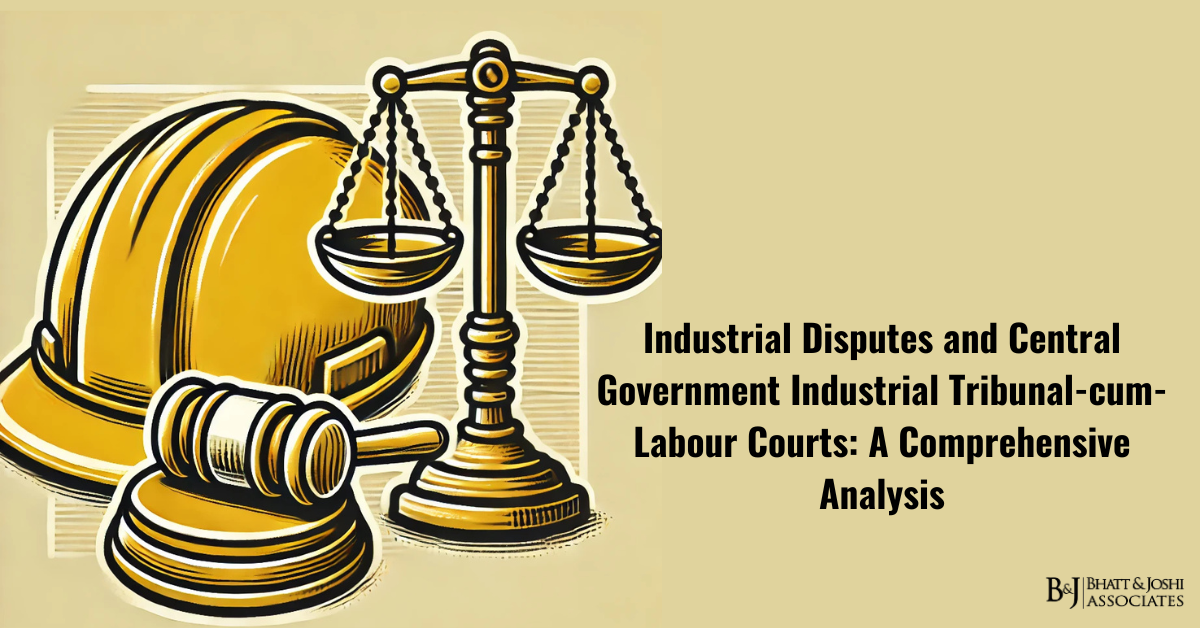Introduction
The Central Government Industrial Tribunal-cum-Labour Courts (CGIT-cum-LCs) represent a cornerstone of India’s industrial dispute resolution mechanism. These specialized judicial bodies were established to address and resolve industrial disputes effectively while ensuring justice for both employers and employees. This comprehensive analysis explores the multifaceted aspects of these tribunals, their evolution, legal framework, and significant impact on industrial relations in India.
Historical Background of Industrial Tribunals in India
The establishment of specialized industrial tribunals in India traces its roots to the colonial period, but the formal institutionalization came through the Industrial Disputes Act, 1947. The post-independence era witnessed significant industrial growth, necessitating a robust dispute resolution mechanism. The Central Government, recognizing this need, established CGITs under Section 7A of the Industrial Disputes Act, 1947, combining them with Labour Courts to create an integrated judicial forum for industrial dispute resolution.
The evolution of these tribunals reflects the changing dynamics of industrial relations in India. Initially focused primarily on wage disputes and working conditions, their scope gradually expanded to encompass complex issues of modern industrial relations, including technological changes, restructuring, and globalization impacts.
Legal Framework of CGIT-cum-LCs
The legal foundation of CGIT-cum-LCs rests primarily on the Industrial Disputes Act, 1947, supplemented by various other labor legislations. The Constitution of India, particularly Articles 323A and 323B, provides the constitutional framework for establishing specialized tribunals. The recent Code on Industrial Relations, 2020, part of the labor law reforms, introduces significant changes to the tribunal system while maintaining its essential character.
Under Section 7A of the Industrial Disputes Act, these tribunals are vested with powers to adjudicate industrial disputes relating to any matter specified in the Second and Third Schedules of the Act. The Industrial Disputes (Central) Rules, 1957, further elaborate on the procedural aspects of tribunal functioning.
Structure and Composition of CGIT-cum-LCs
The CGIT-cum-LCs operate under a well-defined hierarchical structure. Each tribunal is headed by a Presiding Officer, who must possess qualifications equivalent to those of a High Court Judge or must have held a judicial office in India for at least three years. The appointment process, governed by the Tribunal Rules, ensures independence and competence in tribunal functioning.
Supporting the Presiding Officer is an administrative structure including the Registrar, court officers, and other staff. This organizational framework enables efficient case management and timely disposal of disputes. The tribunals function under the administrative control of the Ministry of Labour and Employment, while maintaining judicial independence in their decision-making process.
Jurisdiction and Powers
The jurisdiction of CGIT-cum-LCs extends to industrial disputes in establishments under the central sphere. These include disputes in central public sector undertakings, banking and insurance sectors, ports and docks, mines, oil fields, and major ports. The tribunals exercise both original and appellate jurisdiction, depending on the nature of the dispute.
The powers vested in these tribunals are quasi-judicial, enabling them to summon witnesses, examine evidence, and pass binding orders. They can grant interim relief, issue injunctions, and make awards that are executable as decrees of civil courts. The Code on Industrial Relations, 2020, further strengthens these powers while streamlining the adjudication process.
Procedural Framework
The procedural aspects of CGIT-cum-LCs are governed by detailed rules ensuring fair hearing and expeditious disposal of cases. The process begins with the filing of a statement of claim, followed by written statements, rejoinders, and evidence presentation. The tribunals follow principles of natural justice while maintaining flexibility in procedural matters to ensure accessibility and effectiveness.
Time limits for various stages of proceedings are prescribed to prevent delays. The tribunals can also conduct conciliation proceedings to facilitate amicable settlement of disputes. The procedure emphasizes simplicity and informality compared to regular courts, making it more accessible to workers and trade unions.
Key Functions and Responsibilities of CGIT-cum-LCs
The primary function of CGIT-cum-LCs involves adjudication of industrial disputes including wages, working conditions, disciplinary actions, and retrenchment. They play a crucial role in interpreting labor laws and establishing precedents that guide industrial relations. The tribunals also perform important functions in maintaining industrial peace through their dispute resolution mechanism.
Beyond adjudication, these tribunals contribute to the development of industrial jurisprudence through their reasoned orders and awards. They balance the interests of workers and management while considering economic and social implications of their decisions. The tribunals also ensure compliance with statutory provisions and protection of workers’ rights.
Landmark Judgments
Several landmark judgments of CGIT-cum-LCs have significantly influenced Indian industrial law. The Excel Wear case (1978) established principles regarding closure of undertakings. The Workmen of Meenakshi Mills case (1992) set important precedents regarding wage revision. These decisions demonstrate the tribunals’ role in shaping industrial relations jurisprudence.
The Supreme Court, in cases like Bangalore Water Supply vs. R. Rajappa (1978), has upheld and clarified the jurisdiction and powers of these tribunals. These judicial pronouncements have helped establish clear guidelines for industrial dispute resolution while protecting workers’ rights and maintaining industrial harmony.
Role in Dispute Resolution
CGIT-cum-LCs have emerged as effective forums for resolving industrial disputes through their specialized knowledge and experience in labor matters. Their role extends beyond mere adjudication to include facilitation of settlements and prevention of industrial unrest. The tribunals’ understanding of industry-specific issues enables them to provide practical and implementable solutions.
The dispute resolution process emphasizes conciliation and mediation before formal adjudication. This approach helps maintain harmonious industrial relations while reducing the time and costs associated with lengthy litigation. The tribunals also consider socio-economic factors while resolving disputes, ensuring balanced outcomes.
Analysis of Recent Trends
Recent trends in CGIT-cum-LC functioning reflect adaptation to changing industrial relations patterns. There is increasing emphasis on alternative dispute resolution mechanisms and use of technology in case management. The tribunals are handling more complex cases involving technological change, business restructuring, and global competition impacts.
Statistical analysis shows variations in case disposal rates and types of disputes across different regions. There is a noticeable trend towards more sophisticated legal arguments and representation, reflecting the evolving nature of industrial relations. The tribunals are also addressing new challenges posed by the gig economy and non-traditional employment relationships.
Challenges and Limitations of CGIT-cum-LCs
Despite their crucial role, CGIT-cum-LCs face several challenges. These include case backlogs, infrastructure limitations, and delays in appointment of presiding officers. The increasing complexity of industrial disputes requires continuous updating of knowledge and skills among tribunal members.
Procedural delays, though less than in regular courts, remain a concern. The tribunals also face challenges in enforcing their awards and ensuring compliance with their orders. Limited resources and administrative support sometimes affect their efficiency and effectiveness.
Recommendations for Reform of CGIT-cum-LCs
Several reforms could enhance the functioning of CGIT-cum-LCs. These include strengthening infrastructure, increasing the number of tribunals, and improving case management systems. Regular training and capacity building programs for tribunal members could help address emerging challenges.
Technological upgradation, including electronic filing and case tracking systems, could improve efficiency. Strengthening enforcement mechanisms and introducing time-bound disposal requirements could enhance effectiveness. The new labor codes provide an opportunity to implement these reforms systematically.
Conclusion
The Central Government Industrial Tribunal-cum-Labour Courts remain vital institutions in India’s industrial relations framework. Their specialized nature, expertise in labor matters, and ability to provide expeditious justice make them indispensable for maintaining industrial peace and harmony. While facing various challenges, these tribunals continue to evolve and adapt to changing industrial relations dynamics.
The future role of CGIT-cum-LCs will be crucial as India’s industrial landscape undergoes transformation. Their ability to balance workers’ rights with industrial growth requirements while ensuring justice and fairness will remain important. Continued reforms and strengthening of these institutions will be essential for effective industrial dispute resolution in the changing economic environment.














